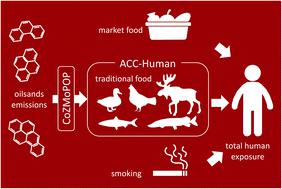当前位置:
X-MOL 学术
›
Environ. Sci.: Processes Impacts
›
论文详情
Our official English website, www.x-mol.net, welcomes your
feedback! (Note: you will need to create a separate account there.)
A multi-pathway exposure assessment for polycyclic aromatic hydrocarbons among residents in the Athabasca oil sands region, Canada
Environmental Science: Processes & Impacts ( IF 4.3 ) Pub Date : 2023-02-28 , DOI: 10.1039/d2em00526c Faqiang Zhan 1 , Abha Parajulee 1 , Matthew J Binnington 1 , Anya Gawor 1 , Frank Wania 1
Environmental Science: Processes & Impacts ( IF 4.3 ) Pub Date : 2023-02-28 , DOI: 10.1039/d2em00526c Faqiang Zhan 1 , Abha Parajulee 1 , Matthew J Binnington 1 , Anya Gawor 1 , Frank Wania 1
Affiliation

|
Due to increasing emissions from ongoing development of the oil sands in Northern Alberta, Canada, there is concern that local residents and organisms are experiencing elevated exposures to hazardous contaminants. We modified an existing human bioaccumulation model (ACC-Human) to represent the local food chain in the Athabasca oil sands region (AOSR), the focus of oil sands development in Alberta. We used the model to assess the potential exposure to three polycyclic aromatic hydrocarbons (PAHs) among local residents that have a high intake of locally sourced traditional foods. To place these estimates into context, we complemented them with estimated PAH intake through market foods and smoking. Our approach was able to produce realistic body burdens of the PAHs in aquatic and terrestrial wildlife and in humans, both in magnitude and with respect to the relative difference between smokers and non-smokers. Over the model simulation period (1967–2009), market food was the dominant dietary exposure route for phenanthrene and pyrene, while local food, and in particular local fish, dominated the intake of benzo[a]pyrene. Exposure to benzo[a]pyrene therefore was also predicted to increase over time in concert with expanding oil sands operations. Those smoking at the average rate of Northern Albertans take in an additional amount of all three PAHs that is at least as large as dietary intake. Estimated daily intake rates are below toxicological reference thresholds for all three PAHs. However, daily intake of BaP in adults is only ∼20 fold below those thresholds and is predicted to increase. Key uncertainties in the assessment included the effect of food preparation on the PAH content in food (e.g., smoking of fish), the limited availability of market food contamination data specific to Canada, and the PAH content of the vapor phase of first-hand cigarette smoke. Considering the satisfactory model evaluation, ACC-Human AOSR should be suited to making predictions of future contaminant exposure based on development scenarios in the AOSR or in response to potential emission reduction efforts. It should also be applicable to other organic contaminants of concern released by oil sands operations.
中文翻译:

加拿大阿萨巴斯卡油砂地区居民多环芳烃多途径暴露评估
由于加拿大阿尔伯塔省北部油砂的持续开发导致排放量增加,人们担心当地居民和生物体暴露于有害污染物的风险增加。我们修改了现有的人类生物累积模型 (ACC-Human),以代表阿萨巴斯卡油砂地区 (AOSR) 的当地食物链,该地区是艾伯塔省油砂开发的重点。我们使用该模型来评估大量摄入本地采购的传统食品的当地居民对三种多环芳烃 (PAH) 的潜在暴露程度。为了将这些估计纳入背景,我们通过市场食品和吸烟估计的 PAH 摄入量对其进行了补充。我们的方法能够在水生和陆生野生动物以及人类中产生 PAHs 的真实身体负担,无论是在幅度上还是在吸烟者和非吸烟者之间的相对差异上。在模型模拟期间(1967-2009),市场食品是菲和芘的主要膳食暴露途径,而当地食物,特别是当地鱼类,主要摄入苯并[]芘。因此,随着油砂作业的扩大,苯并[ a ]芘的暴露量也预计会随着时间的推移而增加。那些以北艾伯塔人的平均吸烟率吸烟的人摄入了至少与膳食摄入量一样多的所有三种多环芳烃。估计的每日摄入率低于所有三种多环芳烃的毒理学参考阈值。然而,成人每天摄入的 BaP 仅比这些阈值低约 20 倍,并且预计会增加。评估中的主要不确定性包括食品制备对食品中 PAH 含量的影响(例如,熏鱼),加拿大特有的市场食品污染数据有限,以及一手香烟烟雾气相中的 PAH 含量。考虑到令人满意的模型评估,ACC-Human AOSR 应该适用于根据 AOSR 中的发展情景或响应潜在的减排努力来预测未来的污染物暴露。它还应适用于油砂作业释放的其他有机污染物。
更新日期:2023-02-28
中文翻译:

加拿大阿萨巴斯卡油砂地区居民多环芳烃多途径暴露评估
由于加拿大阿尔伯塔省北部油砂的持续开发导致排放量增加,人们担心当地居民和生物体暴露于有害污染物的风险增加。我们修改了现有的人类生物累积模型 (ACC-Human),以代表阿萨巴斯卡油砂地区 (AOSR) 的当地食物链,该地区是艾伯塔省油砂开发的重点。我们使用该模型来评估大量摄入本地采购的传统食品的当地居民对三种多环芳烃 (PAH) 的潜在暴露程度。为了将这些估计纳入背景,我们通过市场食品和吸烟估计的 PAH 摄入量对其进行了补充。我们的方法能够在水生和陆生野生动物以及人类中产生 PAHs 的真实身体负担,无论是在幅度上还是在吸烟者和非吸烟者之间的相对差异上。在模型模拟期间(1967-2009),市场食品是菲和芘的主要膳食暴露途径,而当地食物,特别是当地鱼类,主要摄入苯并[]芘。因此,随着油砂作业的扩大,苯并[ a ]芘的暴露量也预计会随着时间的推移而增加。那些以北艾伯塔人的平均吸烟率吸烟的人摄入了至少与膳食摄入量一样多的所有三种多环芳烃。估计的每日摄入率低于所有三种多环芳烃的毒理学参考阈值。然而,成人每天摄入的 BaP 仅比这些阈值低约 20 倍,并且预计会增加。评估中的主要不确定性包括食品制备对食品中 PAH 含量的影响(例如,熏鱼),加拿大特有的市场食品污染数据有限,以及一手香烟烟雾气相中的 PAH 含量。考虑到令人满意的模型评估,ACC-Human AOSR 应该适用于根据 AOSR 中的发展情景或响应潜在的减排努力来预测未来的污染物暴露。它还应适用于油砂作业释放的其他有机污染物。











































 京公网安备 11010802027423号
京公网安备 11010802027423号